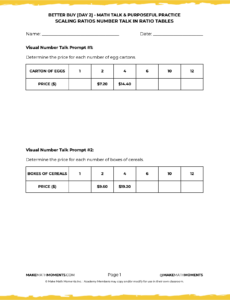Task Teacher Guide
Be sure to read the teacher guide prior to running the task. When you’re ready to run the task, use the tabs at the top of the page to navigate through the lesson.
In This Purposeful Practice…
Students will explore scaling composed unit ratios in tandem in order to compare the price of goods. Students will use this information to determine the best value and develop responsible consumerism.
Intentionality…
The purpose of the Day 2 activities is to reinforce key concepts from Day 1. Students will engage in a math talk and will have an opportunity to complete independent purposeful practice. The math talk and purposeful practice serve to develop a deeper understanding of the following big ideas.
- There are two types of ratios; composed unit ratio and multiplicative comparison ratio;
- A composed unit ratio is often (not always) a ratio with two distinct units;
- A composed unit ratio can be scaled in tandem;
- Quotative division is applied when trying to determine a scale factor between two quantities/measures of the same unit (i.e. dollars and dollars, pounds and pounds);
- Composed unit ratios can be scaled to the same quantity of one variable in order to identify the “better buy”.
Math Talk
Overview of This Visual Math Talk
In today’s visual math talk, we will be scaling a composed unit ratio in tandem through ratio reasoning. This strategy is useful when trying to compare the price of goods.
Through the context of the price and 12-egg cartons, students will be encouraged to leverage the ratio table to scale this composed unit ratio to reveal other values. Throughout the process, encourage students to share and model their mental math strategies and do your best to model them in the ratio table.
Visual Math Talk Prompt #1
Show students the following visual math talk prompt and be prepared to pause the video where indicated:
Then ask students:
If the cost for 2 cartons of eggs is $7.20, how much would it be for 4 cartons of eggs?
The first prompt in this string of related visual number talk prompts involves a pretty low floor giving students two quantities that can easily be doubled by decomposing $7.20 into $7 + $0.20.
2($7 + $0.20)
= $14 + $0.40
= $14.40
Next, the visual number talk prompt video asks students to determine the cost for 1, 6, 10 and 12 egg cartons. The goal here is to promote students leveraging their understanding of scaling up and down the ratio table to reveal additional equivalent composed unit ratios.
While some may choose to add an additional $7,20 to $14.40 to arrive at $21.60 for 6 egg cartons, others may recognize that they can triple the cost of 2 egg cartons since 6 egg cartons is triple that of 2 egg cartons.
Some students may add $14.40 to $21.60 to reveal the cost for 10 egg cartons since those are the costs of 4 egg cartons and 6 egg cartons (additive thinking).
Others may multiply the cost of 2 egg cartons by 5 since 5 groups of 2 egg cartons is equivalent to 10 egg cartons.
Others still may determine the cost of a single egg carton by halving $7.20 and then scale this by a factor of 10.
While we will celebrate all approaches used by students via additive and multiplicative thinking, we do want to explicitly highlight the use of scaling in tandem as this is a multiplicative strategy that is very helpful when working with composed unit ratios.
It is worth noting here that while we can see the cost of a single carton of eggs, the rate (or “unit rate” as some call it) is not explicitly shown here.
Only through partitive division of any of these equivalent ratios (i.e.: 3.60:1, 7.20:2, 14.40:4, etc.) can we reveal the rate of $3.60 per carton of eggs.
Interested in learning more about ratios, rates and proportional relationships? Dig into our course, The Concept Holding Your Students Back.
Visual Math Talk Prompt #2
Show students the following visual math talk prompt and be prepared to pause the video where indicated:
Then ask students:
If the cost for 3 boxes of cereal is $9.60, how much would it be for 6 boxes of cereal?
Again, a very low entry point here promoting students to use the multiplicative thinking strategy of doubling, but still offering access to those students who choose to leverage additive thinking by adding the cost of 3 boxes of cereal.
We then present students with the challenge of determining the cost of various numbers of boxes assuming a constant rate of cost per box.
The values selected here are intentional to promote tripling, thirding and other scale factors as students attempt revealing the prices for various quantities of boxes.
The values selected here are intentional to promote tripling, thirding and other multiplicative strategies.
While different students may use different scale factors to determine various prices in the ratio table, one realization they may make is that determining the price for 1 box of cereal can be helpful to easily determine other scale factors in the table.
While not likely, the following screenshot is shared to intentionally let educators in on a behaviour of scaling that they may not have noticed in the past.
Since 12 boxes is 4 thirds as large as 9 boxes, we can also multiply the cost of 9 boxes by 4 thirds.
While this isn’t extremely helpful for mental math, thinking of 4 thirds as first taking 1 third of 9 to get 3 boxes for $9.60 and then quadrupling will provide an opportunity to arrive at 12 boxes for $38.40.
Purposeful Practice
While Students Are Practicing…
Login/Join to access the entire Teacher Guide, downloadable slide decks and printable handouts for this lesson and all problem based units.
Multiplying and Dividing Integers
Login/Join to access the entire Teacher Guide, downloadable slide decks and printable handouts for this lesson and all problem based units.
We suggest collecting this reflection as an additional opportunity to engage in the formative assessment process to inform next steps for individual students as well as how the whole class will proceed.
Download Editable/Printable Handout
Become a member to access purposeful practice to display via your projector/TV, download the PDF to upload to your LMS and/or print for students to have a physical copy
Resources and Downloads
Lesson Tip Sheet

Download the lesson plan in PDF format so you can keep it handy and share with colleagues.
Videos & Images
 Download the videos, images, and related media files to your computer to avoid streaming.
Download the videos, images, and related media files to your computer to avoid streaming.
Keynote Slides
 Download in Apple Keynote format to avoid streaming video and run the lesson smoothly.
Download in Apple Keynote format to avoid streaming video and run the lesson smoothly.
PowerPoint Slides
 Download in Microsoft PowerPoint format to avoid streaming video and run the lesson smoothly.
Download in Microsoft PowerPoint format to avoid streaming video and run the lesson smoothly.
Printable Handout
Download/Edit the handout so you can keep it handy and share with colleagues.
Explore The Entire Unit of Study
This Make Math Moments Task was designed to spark curiosity for a multi-day unit of study with built in purposeful practice, and extensions to elicit and emerge mathematical models and strategies.
Click the links at the top of this task to head to the other related lessons created for this unit of study.
Visual Math Talk Prompt #1
Visual Math Talk Prompt #2
Question #1
Login/Join to access the entire Teacher Guide, downloadable slide decks and printable handouts for this lesson and all problem based units.
Question #2
Login/Join to access the entire Teacher Guide, downloadable slide decks and printable handouts for this lesson and all problem based units.
Question #3
Login/Join to access the entire Teacher Guide, downloadable slide decks and printable handouts for this lesson and all problem based units.
Question #4
Login/Join to access the entire Teacher Guide, downloadable slide decks and printable handouts for this lesson and all problem based units.
Question #5
Login/Join to access the entire Teacher Guide, downloadable slide decks and printable handouts for this lesson and all problem based units.
Download Editable/Printable Handout
Become a member to access purposeful practice to display via your projector/TV, download the PDF to upload to your LMS and/or print for students to have a physical copy

















